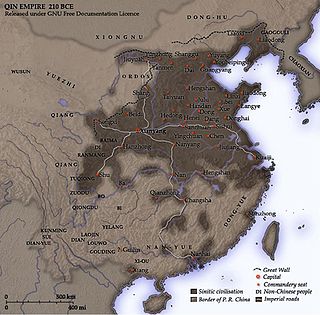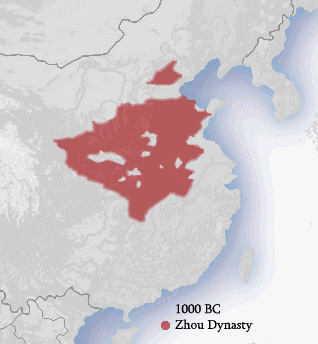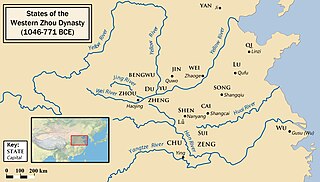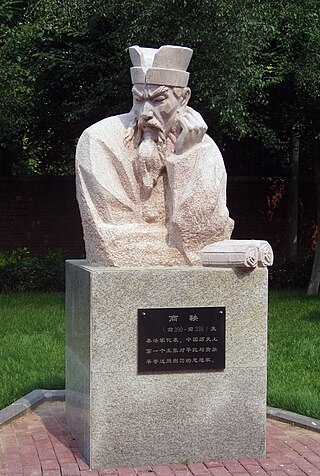
Feudalism, also known as the feudal system, was a combination of legal, economic, military, cultural, and political customs that flourished in medieval Europe from the 9th to 15th centuries. Broadly defined, it was a way of structuring society around relationships derived from the holding of land in exchange for service or labour.

The Qin dynasty was the first dynasty of Imperial China. Named for its origin in the state of Qin, a fief of the confederal Zhou dynasty which had endured for over five centuries—until 221 BC, when it assumed an imperial prerogative following its complete conquest of its rival states, a state of affairs that lasted until its collapse in 206 BC. It was formally established after the conquests in 221 BC, when Ying Zheng, who had become king of the Qin state in 246, declared himself to be "Shi Huangdi", the first emperor.

The Zhou dynasty was a royal dynasty of China that followed the Shang dynasty. Having lasted 789 years, the Zhou dynasty was the longest dynastic regime in Chinese history. The military control of ancient China by the royal house, surnamed Ji, lasted from 1046 until 771 BC for a period known as the Western Zhou, and the political sphere of influence it created continued well into the Eastern Zhou period for another 500 years. The establishment date of 1046 BC is supported by the Xia–Shang–Zhou Chronology Project and David Pankenier, but David Nivison and Edward L. Shaughnessy date the establishment to 1045 BC.

Serfdom was the status of many peasants under feudalism, specifically relating to manorialism, and similar systems. It was a condition of debt bondage and indentured servitude with similarities to and differences from slavery. It developed during the Late Antiquity and Early Middle Ages in Europe and lasted in some countries until the mid-19th century.

A fief was a central element in medieval contracts based on feudal law. It consisted of a form of property holding or other rights granted by an overlord to a vassal, who held it in fealty or "in fee" in return for a form of feudal allegiance, services or payments. The fees were often lands, land revenue or revenue-producing real property like a watermill, held in feudal land tenure: these are typically known as fiefs or fiefdoms. However, not only land but anything of value could be held in fee, including governmental office, rights of exploitation such as hunting, fishing or felling trees, monopolies in trade, money rents and tax farms. There never existed a standard feudal system, nor did there exist only one type of fief. Over the ages, depending on the region, there was a broad variety of customs using the same basic legal principles in many variations.

The Western Zhou was a period of Chinese history, approximately first half of the Zhou dynasty, before the period of the Eastern Zhou. It began when King Wu of Zhou overthrew the Shang dynasty at the Battle of Muye and ended when Quanrong pastoralists sacked its capital Haojing and killed King You of Zhou in 771 BC.
King Nan of Zhou, less commonly known as King Yin of Zhou, was the 37th and last king of the Chinese Zhou dynasty, the son of King Shenjing of Zhou and grandson of King Xian of Zhou. He was king from 314 BC until his death in 256 BC, a reign of fifty-nine years, the longest in the Zhou Dynasty and all of pre-imperial China. By the time of King Nan's reign, the kings of Zhou had lost almost all political and military power, as even their remaining crown land was split into two states or factions, led by rival feudal lords: West Zhou, where the capital Wangcheng was located, and East Zhou, centred at Chengzhou and Kung. Therefore, Nan lacked any personal territory and was effectively under the control of the local feudal lords, essentially relying on their charity.

Shang Yang, also known as Wei Yang and originally surnamed Gongsun, was a statesman, chancellor and reformer of the State of Qin. Born in the Zhou vassal state of Wey during the Warring States period, he took up office in the Qin state, where his policies laid the administrative, political and economic foundations that would eventually enable Qin to conquer the other six rival states, unifying China into a centralized rule for the first time in history under the Qin dynasty. Scholars consider it likely that both he and his followers contributed to The Book of Lord Shang, a foundational philosophical work for the school of Chinese legalism.

The Qin officially the Great Qin, was an ancient Chinese state during the Zhou dynasty. It is traditionally dated to 897 BC. The Qin state originated from a reconquest of western lands that had previously been lost to the Xirong. Its location at the western edge of Chinese civilisation allowed for expansion and development that was not available to its rivals in the North China Plain.

A mesne lord was a lord in the feudal system who had vassals who held land from him, but who was himself the vassal of a higher lord. Owing to Quia Emptores, the concept of a mesne lordship technically still exists today: the partitioning of the lord of the manor's estate among co-heirs creating the mesne lordships.

In the Middle Ages, especially under the European feudal system, feoffment or enfeoffment was the deed by which a person was given land in exchange for a pledge of service. This mechanism was later used to avoid restrictions on the passage of title in land by a system in which a landowner would give land to one person for the use of another. The common law of estates in land grew from this concept.
In the law of the Middle Ages and early modern period, especially within the Holy Roman Empire, an allod, also allodial land or allodium, is an estate in land over which the allodial landowner (allodiary) had full ownership and right of alienation.
Fēngjiàn was a governance system in Ancient China and Imperial China, whose social structure formed a decentralized system of confederation-like government. The ruling class consisted of the Son of Heaven and aristocracy, and the lower class consisted of commoners categorized into four occupations. Elite bonds through affinal relations and submission to the overlordship of the king date back to the Shang dynasty, but it was the Western Zhou dynasty when the Zhou kings enfeoffed their clan relatives and fellow warriors as vassals. Through the fengjian system, the king would allocate an area of land to a noble, establishing him as the ruler of that region and allowing his title and fief to be legitimately inherited by his descendants. This created large numbers of local autonomous dynastic domains.

Georgian feudalism, or patronkmoba, as the system of personal dependence or vassalage in ancient and medieval Georgia is referred to, arose from a tribal-dynastic organization of society upon which was imposed, by royal authority, an official hierarchy of regional governors, local officials and subordinates. It is thought to have its roots into the ancient Georgian, or Iberian, society of Hellenistic period.

Ancient Chinese states were dynastic polities of China within and without the Zhou cultural sphere prior to Qin's wars of unification. They ranged in size from large estates, to city-states to much vaster territories with multiple population centers. Many of these submitted to royal authority, but many did not—even those that shared the same culture and ancestral temple surname as the ruling house. Prior to the Zhou conquest of Shang, the first of these ancient states were already extant as units of the preceding Shang dynasty, Predynastic Zhou, or polities of other cultural groups. Once the Zhou had established themselves, they made grants of land and relative local sovereignty to kinfolk in return for military support and tributes, under a system known as fengjian.

Feudalism as practiced in the Kingdoms of England during the medieval period was a state of human society that organized political and military leadership and force around a stratified formal structure based on land tenure. As a military defence and socio-economic paradigm designed to direct the wealth of the land to the king while it levied military troops to his causes, feudal society was ordered around relationships derived from the holding of land. Such landholdings are termed fiefdoms, traders, fiefs, or fees.
Duke Xiang of Qin aka by his nomen ,Ying Kai ,was from 777 to 766 BC the sixth ruler of the Zhou Dynasty vassal state of Qin, which eventually unified China to become the Qin Dynasty. His ancestral name was Ying ,Kai as his nomen and Duke Xiang was his posthumous title. He was the first Qin ruler to be granted a nobility rank by the king of Zhou; under his reign, Qin was formally recognized as a major vassal state of Zhou China.
Feudalism in the Holy Roman Empire was a politico-economic system of relationships between liege lords and enfeoffed vassals that formed the basis of the social structure within the Holy Roman Empire during the High Middle Ages. In Germany the system is variously referred to Lehnswesen, Feudalwesen or Benefizialwesen.

The Eastern Zhou is a period of Chinese history, approximately the second half of the Zhou dynasty, following the Western Zhou period. Characterised by weak central government, it is subdivided into two periods: the Spring and Autumn, during which the ancient aristocracy still held power in a large number of separate polities, and the Warring States, which saw the consolidation of territory into a few domains and the dominance of other social classes. "Eastern" refers to the geographic situation of the royal capital, near present-day Luoyang.
The political systems of Imperial China can be divided into a state administrative body, provincial administrations, and a system for official selection. The three notable tendencies in the history of Chinese politics includes, the convergence of unity, the capital priority of absolute monarchy, and the standardization of official selection. Moreover, there were early supervisory systems that were originated by local factions, as well as other political systems worthy of mention.










